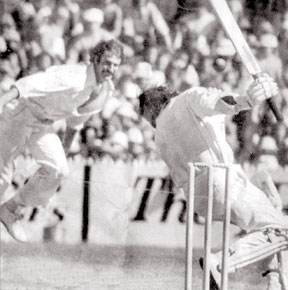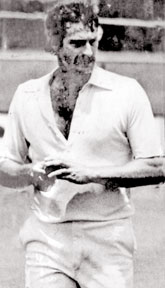Dennis Lillee - champion fast bowler became coach on retirement
By A. C De Silva
The breathtaking run-up of Wes Hall
The silk-smooth delivery of Ray Lindwall
The blistering pace of Jeff Thomson
The firebrand aggression of Freddie Trueman
The Scintillating swing of Alan Davidson
The devastating cut of John Snow
The nagging accuracy of Brian Statham
The lethal bouncer of Charlie griffith
The demoralising yorker of Andy Roberts
The unstinting stamina of Mike Procter
The sheer brilliance of Keith Miller
One of Australia’s greatest fast bowlers, Dennis Lillee was formally
inducted into the ICC Cricket Hall of Faire on the second day of the
third test between Australia and the West Indies in Perth in December
2009.
|

Dennis Lillee (left) gives the then Pakistan Captain Mushtaq Mohammad the
treatment at the MCG in the picture of 1977 |
The Hall of Fame, run in association with the Federation of
International Cricketer’s Associations (FICA) recognises some of the
truly great players from cricket’s long and illustrious history.
A commemorative cup was presented to Lillee by the International
Cricket Council (ICC) Director and Cricket Australia Chairman Jack
Clarke in front of large and appreciative crowd at western Australia
Cricket Association ground (WACA). He was then driven around the oval in
an open top vehicle to allow his home fars to show their appreciation
for the legendary fast bowler.
If one is to find the man who can enabody all those attributes and
the man who can be picked and fitted into all those categories will be
that bowler from Australia Dennis Keith Lillee.
Lillee a saga of courage
The bowling of Lillee was a saga in coverage as he came back from a
back infans which would have crippled any other mortal. The two years in
the wilderness saw the transformation of Lillee from a tearaway to a
controlled pace bowler who leant every method of making the shire and
seam do.
He was an outstanding fast bowler and could be said was the very
epitome of the modern man. He appeared for Australia with tremendous
force. He had a fling against England at the Adelaide Oval in the
1970-71 series taking 5 wickets for 40 runs and none for 84 in the drawn
test. His first victim was Allan Knott who was caught by Ian Redpath for
seven.
Though he retired from cricket, he did not fadeaway. He stamped his
name in the annals of Australian cricket by capturing 355 wickets in 70
tests – a feat not reached by any other Australian bowler until Shane
Warne did so much later. Lillee took 5 wickets 23 times and 19 wickets
in a match seven times.
After having made his debut in the sixth test against England at
Adelaide in the 1970-71, he became one of Australia’s greatest fast
bowlers and was formally inducted into ICC Cricket Hall of Fame. Hall of
Fame, is run in association with the Federation of International
Cricketers Association (FICA) recognises some of the truly great players
from cricket’s long and illustrious history.
A fling with world XI
The next fling was when Lillee took on the might of the World XI
side.
|

Dennis Lillee – a great pace bowler |
The Lillee effect was instantaneous. As sobers, the captain of the
elite outfit observed: ‘The moment that when he went into bat at 46 for
5, he can honestly say that it was the only occasion in his career when
he (Sobers) felt anxious about his Physical well-being.
Sobers says normally fast bowling did not worry him. However, this
was the first time that he faced the fastest bowler in the world on the
fastest pitch in the world – (Perth). The Perth turf was giving Lillee
great assistance, and what more – Sobers says that he did not have
protective gear, which became a common thing later on.
Lillee was a bowler who compromised. He did things intelligently. He
got over four stress features and returned every time a better bowler.
In 1973-74, Lillee was relegated to the rank of a club cricketer from
the high pedestal. He bounced back as only he could with sheer will
power and scientific training on a treadmill. He joined
hands with Thomson, just a year later, and forced the battle-scared
English batsman to run for cover. While the Aussie crowds chanted, “Lillee....eee,
Lill...eeee,” urging him to do better and better, England suffered more
humiliation.
Cowdrey advised Lillee
Only Cowdrey, at the twilight of his career, stood firm among the
rains – a great lesson, from a batting wizard, to a great fast bowler in
the making.
However, it was not the end for Lillee at Cricket. Though he was
unable to play cricket, he did the next best thing – he turned coach.
He became a very useful coach and gave valuable advice to youngsters
who had the idea of becoming fast bowlers’ coach.
Besides being an adviser, he was a regular at the MRF Pace Foundation
in Chennai and coached the Young Indian youngsters in the correct art of
pace bowling.
Lilee’s coaching was not only in India. He also conducted coaching
sessions at the MRF Pace Australia at the WACA. Cricketers like Dennis
Lillee are not born everyday and the services he had rendered should be
treasured for many years to come.
When Lillee started his coaching in Madras, he said. “To be a good
pace bowler, you have to have a solid foundation. When I was in my early
teens, I would have been happy it I had an opportunity to talk to and
work with men like... Keith Miller and Ray Lindwall. It would have
helped me became a better bowler early on.” |

